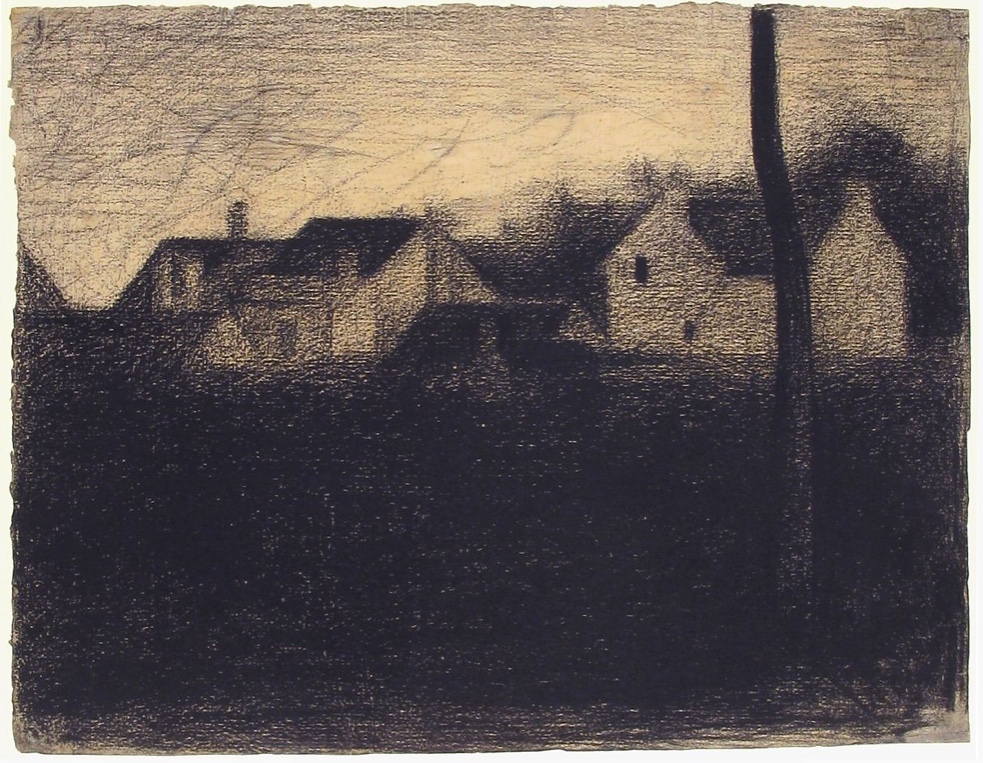For this research point I was asked to look at urban environment landscapes. I started by looking at John Virtue and the work he produced while associate artist in residence at the National Gallery between 2003 and 2005.
John Virtue is a landscape artist whose drawings look almost abstract. He often works from the landscape of where he happens to be living at the time, in this case it was London.
John Virtue works in black and white. He uses acrylic paint, black ink and shellac and works on canvas.
John Virtues London Paintings focus on the London skyline, where he often showed popular landmarks such as St Paul’s Cathedral.
Below is one example of his works from this time, landscape no. 664

Art UK. (2020) Landscape No.664 John Virtue. At: https://artuk.org/discover/artworks/landscape-no-664-29490 (Accessed 16/04/2020).
This is a landscape drawing of a view along the river Thames. It shows a view of St Paul’s Cathedral and Blackfriars Bridge. At first these are the only two aspects of London I recognised, and the rest appeared to me like a vast amount of blackness. However over time and really looking that this image I began to notice other elements such as the boats on the river.
I find his drawings really emphasise the hazy and smoggy side of London, he shows this through his rich over use of black, and his works almost smudgy abstract appearance. I love the subtlety’s of his detail and the extravagant mood and atmosphere he manages to portray.
The next artist I looked at was Nathan Walsh. Nathan Walsh is an English artist who paints ultra realistic urban landscapes. One of the reasons I chose to look at him was because of his use of perspective in his work as this is what I have been studying recently.
Below is an example of his work:

Walsh often exhibits his detailed line drawings alongside his final paintings. It is obvious from these drawings that he firstly establishes his horizon line and then works with lines of perspective from there (exactly how this course has so far taught us to do.)
I love how his final pieces show a mixture of ultra photo realism and an illustrative element, for example the puddles on the pavement could be a photograph whereas the tree in the centre looks like an illustrative drawing.
The next artist I decided to look at was Craig McPherson. Craig McPherson is known for his urban landscape paintings of New York City. Below is an example of one of his works,

Craig Mcphearson (2020.) Yankee Stadium at Night. At: http://craigmcpherson.net/mezzotints/Yankee-Stadium-at-Night-detail.html (Accessed 16/04/2020).
One of the reasons I chose to look at Craig McPherson’s work, was it showed striking similarities to John Virtues black and white paintings. However rather than using Acrylic paint and ink like John Virtue, Craig McPherson uses mezzotint, a type of print method used with copper or steel plates. This is a process I have never used before or even heard of so it was something I found exciting and fascinating.
I was really inspired by Craig McPherson’s Yankee Stadium at night. I love his use of vivid light and the amazing atmospheric perspective that is shown. (This is something I failed to achieve successfully in my own work on my previous exercise, so is a technique I am very interested in now.
I feel his work is very dramatic and I love it’s vast composition. Unlike John Virtues work Craig McPhersons detail is sharp and obvious. This works makes my eye travel around the piece at great speed it feels like I can’t get enough of every tiny aspect quick enough.
In conclusion all three artists show wildly different styles and techniques whilst still maintaining an exciting portrayal of urban landscapes. Moving forward I would like to be able to use their work to inspire my own drawings including John Virtues use of mood and atmosphere, Nathan Walsh’s incredible detail and realism and
Craig McPherson’s use of atmospheric perspective.
Bibliography:
The National Gallery. (2020) John Virtue. At: https://www.nationalgallery.org.uk/learning/associate-artist-scheme/john-virtue (Accessed 16/04/2020).
Wikipedia. (2020) John Virtue. At: https://en.m.wikipedia.org/wiki/John_Virtue (Accessed 16/04/2020).
Schama, S. (2005) This is London in all its rain-sodden, beery-eyed, nervy exhilaration. At: https://www.google.com/amp/s/amp.theguardian.com/artanddesign/2005/feb/28/art (Accessed 16/04/2020).
Yale Centre for British Art (2020) John Virtue. At: https://britishart.yale.edu/exhibitions/london-john-virtue (Accessed 16/04/2020).
Art UK. (2020) Landscape No.664 John Virtue. At: https://artuk.org/discover/artworks/landscape-no-664-29490 (Accessed 16/04/2020).











